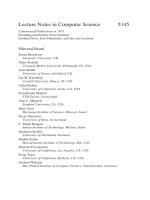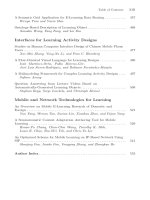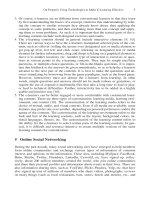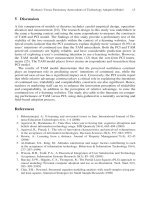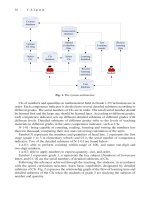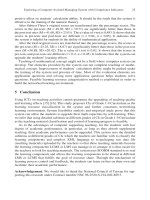Lecture Notes in Computer Science- P59 pptx
Bạn đang xem bản rút gọn của tài liệu. Xem và tải ngay bản đầy đủ của tài liệu tại đây (126.59 KB, 5 trang )
Learning Kruskal's Algorithm, Prim's Algorithm and Dijkstra's Algorithm by Board Game 279
(4) All the players have to learn the related knowledge about the shortest path algo-
rithm and minimum spanning tree.
5.3 Game Progress
In the new edition of Ticket to Ride, we fixed some rules based on original rules be-
cause of our ideal – combining the board game and three minimum spanning tree
theories. The progress is likely the original game. The difference between new and old
edition games is that we gave the new game an additional element. The element is the
concept of start location and minimum spanning tree theories cards. First, players
should cast a start point and knowledge card. Then, they should choose if they want
them. After casting start point and knowledge cards, players begin to a single turn.
In the single turn, players can do three actions:
(1) Draw two of the railway cards or choose one which is opened directly.
(2) Draw three of the 3 ticket cards, and reserve the selected ticket.
(3) Re-cast new start point card and knowledge cards.
(4) Put the railway carriages on the map to establish the route. Players also can skip
the step if there is no available condition.
In principle, the game will repeat these four steps until a player rich the end condi-
tions of single round game. The game progress graph is shown in Fig.2.
5.4 Game Regulations
There are the descriptions of the game regulations.
(1) The station recorded in the starting point card has to match the stations in the
knowledge card else the player cannot play the game (example is shown in
Table 1).
(2) Regulations of drawing the railway card:
a. Railway card color: white
black red yellow orange blue purple
green full-color.
b. In the beginning of each round, the railway cards are divided into two piles.
One is composed of five opened cards and the other one is covered pile of
cards.
c. When drawing the cards, each player can select two cards from the covered
pile of cards else select the card from five opened cards. It means player can
get the wanted card which is opened.
(3) Players can give up the knowledge card in hands, and player’s score will be
detected according to the card. Then the player proceeds game from pick up the
starting point.
(4) After the player completed one knowledge card, player can decide if he/she will
continue draw next knowledge card or not.
(5) Establish the player’s railway routes:
a. The color of the railway card and spaces of the map routes are matched, then
the railway cards can occupy the routes of the railway map. The full-color card
can occupy any color routes on the map. For example, there are three white
280 W C. Chang, Y D. Chiu, and M F. Li
spaces on the route [BRAGANCA-BENAVENTE], the player can occupy the
route with three railway cards combination. First one is three white railway
cards; Second is two white and one full-color railway cards; Third is one white
and two full-color railway cards; Fourth, three full-color railway cards. The
other card combinations are useless.
b. Grey route is available for all the colors. For example, there are three grey
spaces on the route [BRAGANCA-SALAMANCA], any kinds color of rail-
way cards are acceptable, such as two orange and one red railway cards.
c. The quantity of the railway cards and spaces of the map routes are matched,
then the railway cards can occupy the routes of the railway map.
d. If the route of the map is occupied by other players, this route cannot be used
by others.
5.5 Score Rules
The score rules of this game are listed in the following:
(1) The player will gain 10 score if the player used the most railway carriages.
(2) If the ticket card is completed, the player will get the score on the card. On the
country, the player did not complete the ticket card will deduct the score.
(3) The score of ticket card is calculated by the shortest path from starting point to
destination. For instance, the route. For instance, the route, [VALENCA-VERIN]
shortest path is 3 and the route [VALENCA-BRAGA] shortest path is 2, others
are following the rules.
(4) Knowledge card score consists of two parts; first one is partial score when the
player completed part of the answer route, second is completed score when the
player completed all the answer routes. (example is shown in Table 2)
In order to encourage the player follow the correct algorithm, we give high scores for
players. We give a sample of Dijkstra’s algorithm in Table 2. When the player com-
pleted one edge of the answer route and the railway carriages establish order is exactly
the same as the Dijkstra’s algorithm, the player will get the score with three times of the
spaces number of the edge. The edge from VALENCA to VERIN has 3 spaces of
railway carriage; the gaining score is 3*3=9.
The completed score is based on the railway stations in the knowledge card. After
players completed the correct order of the algorithm, then players get the completed
score.
Table 1. Example of choosing start point card and knowledge card
The starting
point card player
owned
The recorded linked stations on the
knowledge card
Result
VERIN
VALENCA, BRAGA, CHAVES,
VILA REAL, BRAGANCA
Useless knowledge card
VERIN
VALENCA,BRAGA, CHAVES,
VERIN, BRAGANCA
Usable knowledge card
Learning Kruskal's Algorithm, Prim's Algorithm and Dijkstra's Algorithm by Board Game 281
Fig. 2. Single round for each player
282 W C. Chang, Y D. Chiu, and M F. Li
Table 2. Example of accomplish Knowledge cards and ticket cards
Connected Railway
Stations
Knowledge Partial Score Completed Score
VALENCA,VERIN,BENAV
ENTE,BRAGANCA,CHAV
ES,BRAGA, PORTO
Dijkstra’s algorithm spaces number
of the route*3
14
VALENCA,VERIN,BENAV
ENTE,BRAGANCA,CHAV
ES,BRAGA, PORTO
Prim’s algorithm spaces number
of the route *2
14
VALENCA,VERIN,BENAV
ENTE,BRAGANCA,CHAV
ES,BRAGA
Prim’s algorithm spaces number
of the route *2
12
Table 3. Comparison with traditional Education and Teaching combining board game
Traditional
Education
Teaching minimum spanning
tree theories combining
board game
Darren Lim ’s theory
Efficiency in
learning
Teachers’ ability
effect the level of
efficiency in
learning.
Students can clarify their
learning problem with game.
Students can clarify
their learning
problem with game.
Interest in
learning
Hard to let student
interested in
learning.
Easier to make students
interested in learning.
Easier to make
students interested
in learning.
Students’
feeling in
learning
spanning
three
theories.
Abstract Easier to catch the theories Easier to catch the
theories
Prepare
before
learning
None Students have to contact this
kind of knowledge before.
Students have to
contact this kind of
knowledge before.
Usable
computer
science
All computer
sciences
Graph theory Programming, Data
Structure, Graph
Theory
6 Comparison
In this section, we compare this kind of teaching combining board game with tradi-
tional education and Darren Lim’s theory [1] in several points of view in Table 3.
After the comparison, we can clearly find the advantage in teaching minimum
spanning tree theories combining board game. These advantages are:
(1) Efficiently in learning: Students can use an existence to help them to learn, the
minimum spanning tree theories are not abstracts, again.
Learning Kruskal's Algorithm, Prim's Algorithm and Dijkstra's Algorithm by Board Game 283
(2) Interest in learning: Because of this tool is game, so students can learn knowledge
with playing game. Anyway, playing is always funnier than sitting in the class-
room.
On the other hand, teaching minimum spanning tree theories combining board game
also have a weak point. Students have to know this kind knowledge first, then, they can
use the game help learning, and Darren Lim’s theory is, too.
Compare with Darren Lim’s theory, we can find Darren Lim’s theory can use in
more computer science, but depth of implement, we have concreteness ideas.
We made an additional comparison table shown in Table 4. In Table 4, we compare
our ideal with Darren Lim’s theory in the points of view “how to implement”, “usable
range”, and “if the ideal be computerized”. We can dig out a characteristic in Darren
Lim’s theory. The characteristic is the theory can be use in widen range. In the other
hand, our ideal is better in having a clear and definite way to implement it.
Table 4. Comparison with Darren Lim’s theory
Teaching minimum spanning
tree theories combining board
game
Darren Lim’s theory
If the ideal be
computerized?
On cybernation No mention
How to teach these
concepts?
Have clear and definite rules to
express concepts
Abstract ideal and no de-
tailed description
Usable range in
computer science
Only in graph theory Not only in graph theory, but
also in data structure and
programming
7 Conclusion
How to teach and learn the theories of graph is an important to teachers and students.
And, how to express some abstract knowledge concepts is difficult. But there, we use
game to express and help students to learn minimum spanning tree theories.
By this way, we believe that these minimum spanning tree concepts can be learned
much more efficiently. If the idea – combining board game Ticket to Ride with
minimum spanning tree theories can be cybernated, the speed of learning must be
shorter and the efficiency would be higher.
Acknowledgements
We would like to thank National Science Council and Chung Hua University. This
research was supported in part by a grant from NSC 96-2520-S-216-001 and CHU
96-2520-S-216-001, Taiwan, Republic of China. This paper owes much to the
thoughtful and helpful comments of the reviewers.

